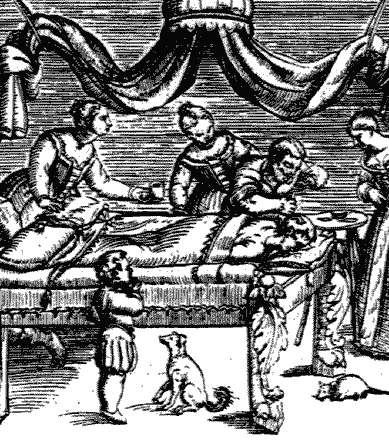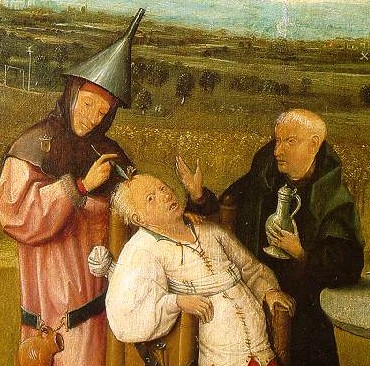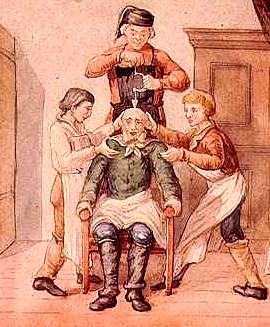|
TrepanationTrepanation is the fine art of boring a hole in the skull in order to release the pressure of imbalanced bodily humours, or to allow brain tissues to "pulsate" freely, or to increase the flow of blood to the brain by creating an outtake valve, or possibly just to let the demons out so they'llstoptalkingtalkingalwayswiththevoicesscreamingatmeandtellingmetokillkillkillkill...
Trepanation is the oldest known surgical technique, perhaps only by virtue of the fact that soft tissues decay while skulls fossilize. On the other hand, it's tough to imagine Gaulish barbarians performing appendectomies or face lifts, so why quibble. Seniority does not always equate to righteousness, however. "Just because the cavemen did it" isn't a good reason for us to continue doing it. Cavemen did a lot of things, such as eating lice off of each other's backs and sleeping with their sisters. Humankind has a collective desire to return to a life of simplicity, but that doesn't mean we should go back to rolling in our own filth or drilling holes in our skulls without a very good reason. But the instinct for nostalgia is potent enough that virtually no medical technique ever truly dies. Trepanation was practiced widely from the Ancient World through medieval times. The key element of the technique is drilling a hole big enough that the bone won't mend. Trepanation was used to treat virtually every disease or disorder that involved the head or the mind, and a few others for good measure. It was effective against exactly none of these disorders. That's not to say there are no legitimate reasons for drilling a hole in the head. There are a few, it's just that the ancients didn't have any way to diagnose them.
It's easy to understand how a medieval barber, whose primary medical technique involved leeches, might see trepanation as a useful method for treating illness. What's rather more difficult to understand is why anyone would support the idea in this day and age. Nevertheless, a rather surprising number of people are still willing to go to rather inexplicable lengths to preach the virtues of drilling a hole in one's head in the absence of any pressing medical need. Instead, the Trepanation Nation believes that drilling is the path to inner peace, cosmic consciousness and plain old good times. One of the most vocal advocates of trepanation is Bart Huges, a Dutch drug guru who aspired to be the same sort of brilliant-but-crazy magnet as Abby Hofmann or Terence McKenna. He got it half-right, at least. Huges (who once told an interviewer "I had twenty-five girlfriends when I was eleven") claims that he found enlightenment via trepanation. Huges got the idea for trepanation when he realized that could get high by standing on his head. (The pot he smoked just before standing on his head had nothing to do with it.) While in prison, Huges decided somehow that the experience of standing on his head would be enhanced if he drilled a hole at the spot mystics normally designate as the "third eye." According to Huges: In prison, having checked the mechanism by perceiving the cerebrospinal fluid in the back outside the central nervous system (...) I thought about making a hole at the base of the spine to let the fluid out, and while thinking about holes I realized that pressure was necessary to squeeze the cerebrospinal fluid out of the system. Then, having concluded upon the nil pressure inside the adult skull -- in most people the skull seals between the ages of eighteen and twenty-two -- I saw that any hole in the bony surrounding of the system would give the pressure back. But after a time I realized a hole in the spine would heal over so it had to be in the skull, where holes stay open.  If you can decipher that paragraph, more power to you. The upshot of all this is that Huges drilled a hole in his own forehead (after several doctors refused to accommodate his request). According to Huges, the trepanation led him to a higher state of consciousness. (The mescaline he took just after drilling the hole in his head had nothing to do with it.)
If you can decipher that paragraph, more power to you. The upshot of all this is that Huges drilled a hole in his own forehead (after several doctors refused to accommodate his request). According to Huges, the trepanation led him to a higher state of consciousness. (The mescaline he took just after drilling the hole in his head had nothing to do with it.) Huges claimed that as a result of this operation he became "permanently high." Huges also claims that people who think trepanation is a load of crap are simply suffering from ill-effects caused by lack of trepanation. If the skeptics just had holes drilled in their heads, they'd understand. This point of view was adopted by a small but vocal handful of people who were... Well, let's call them "open-minded." People like Peter Halvorson, a student of Huges, who now leads the International Trepanation Advocacy Group. ITAG works to spread the good news about trepanation via testimonials, interviews, "research" articles and by publishing a wide variety of barely coherent arguments in favor of the practice. According to ITAG's Web site, "Some of us are willing to present ourselves publicly so that the old stigma associated with making a hole in the skull will be worn down over time." And we applaud their courage. Halvorson explained the advantages to Salon Magazine in 1999, noting that after trepanation, "you look at problems as a source of entertainment." (One can indeed imagine that many of life's problems would seem relatively unimportant compared to having a hole drilled in one's head.) According to Halvorson: I have no problem taking ridicule from the general public. But I expect doctors to act as scientists. They have a professional responsibility to respond to this from an academic viewpoint. In the back of their minds they know that something good happens when you open the skull. Eventually they'll come around.The doctors and scientists interviewed by Salon for the same article described trepanation as "quackery," "buncombe," "horseshit," "absolute, unequivocal bullshit" and "dangerous." According to Dr. Robert Daroff, a professor of neurology, "This is a crackpot notion that's not worthy of my time. And not only that -- it's dangerous. You expose your precious brain, you remove God's covering, there's a risk of infection and all sorts of other problems." So their support must be really far in the back of their minds. But not so far back that a good drilling won't uncover it!
|
 Uh, sorry. Anyway, back to trepanation. About 7,000 years ago, someone in France drilled a hole in someone else's skull, marking the birth of surgery as we know it.
Uh, sorry. Anyway, back to trepanation. About 7,000 years ago, someone in France drilled a hole in someone else's skull, marking the birth of surgery as we know it.  Sometimes when a person suffers a skull injury, cerebrospinal fluid can collect in the brainpan and create immense pressure which needs to be manually relieved... with a drill. Drilling can also be used, albeit rarely, to create an opening for minor brain surgery or to insert electrodes for certain kinds of research.
Sometimes when a person suffers a skull injury, cerebrospinal fluid can collect in the brainpan and create immense pressure which needs to be manually relieved... with a drill. Drilling can also be used, albeit rarely, to create an opening for minor brain surgery or to insert electrodes for certain kinds of research.